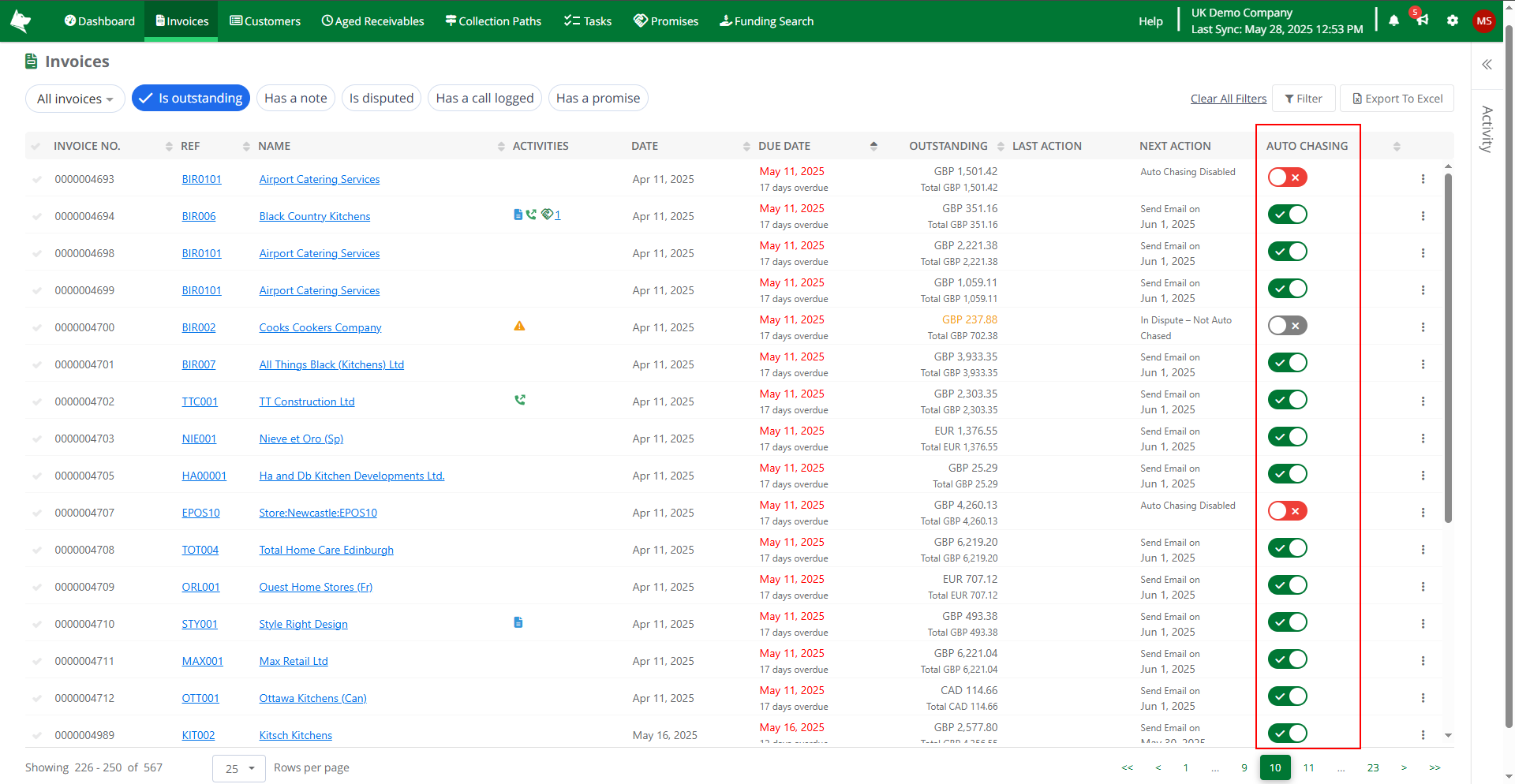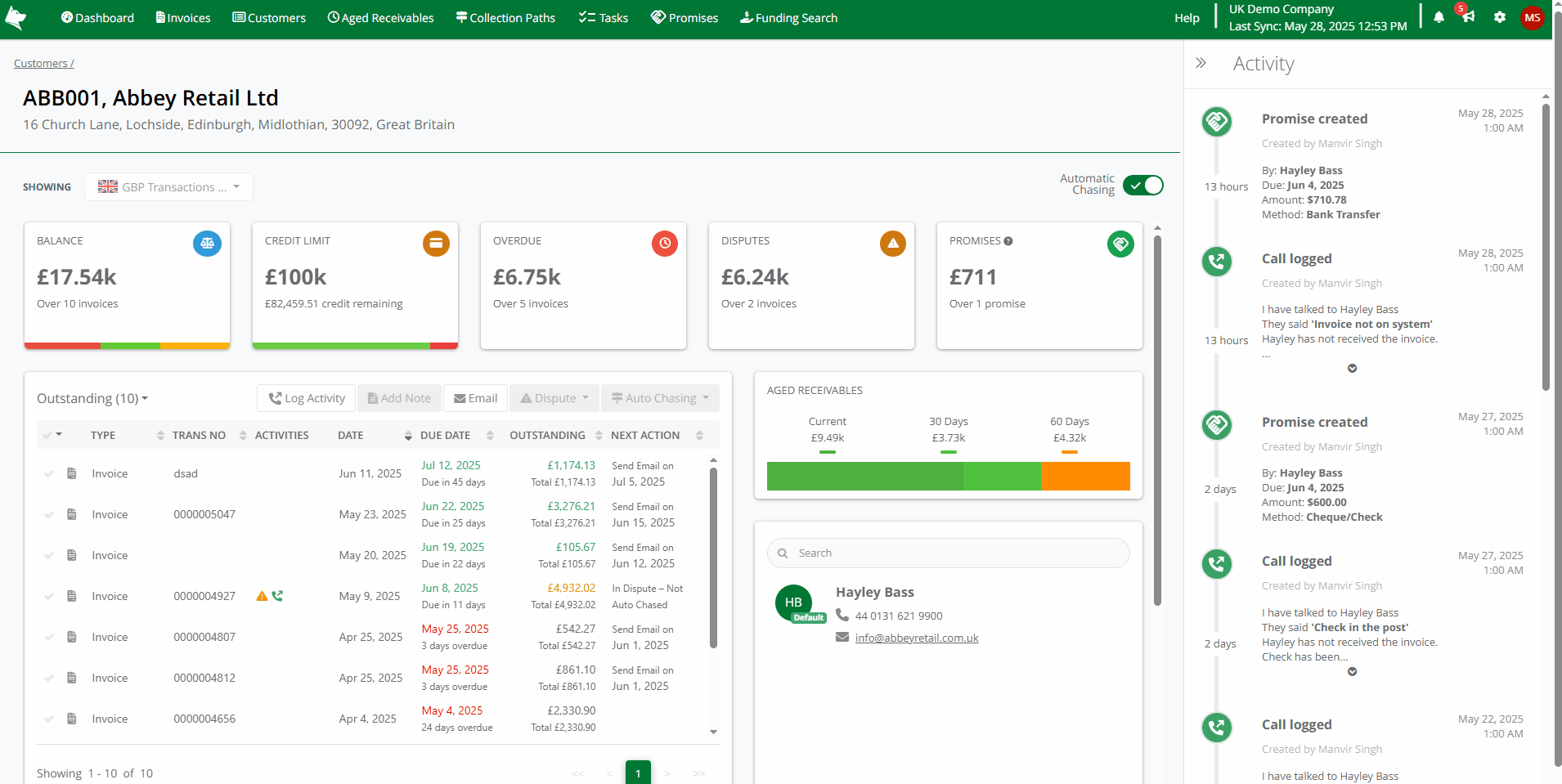Credit Hound Cloud can automatically chase your invoices for payment when Collection Paths are enabled. By default, all invoices have Automatic Chasing enabled, meaning they will follow the actions defined in your Collection Paths.
However, there may be times when you want to exclude specific invoices from being chased. For example, if the invoice is sensitive and should not trigger a strong collection step (e.g., a legal notice). In these cases, you can disable Automatic Chasing for the individual invoice.
You can manage the Automatic Chasing setting from two places:
- The Invoices List
- The Customer Screen
Invoices List
You can enable or disable Automatic Chasing directly from the Invoices List by using the toggle in the Auto Chasing column.
 Invoices List
Invoices ListEach invoice row includes a toggle to control whether it will be automatically chased.
- ✅ A green tick indicates chasing is enabled
- ❌ A red cross indicates chasing is disabled
- A greyed-out toggle means the chasing status cannot be changed (see below for reasons)
In some cases, the toggle in the Auto Chasing column may appear greyed out and cannot be changed. This means the chasing status for the invoice is locked, and cannot be enabled or disabled manually. Below are the reasons this might occur:
- The Customer itself has Automatic Chasing turned off
- The invoice is disputed
- The invoice was previously disputed
- The invoice is not outstanding (e.g., fully paid or fully allocated)
Invoices in these states will not be included in your Collection Path actions, regardless of toggle status.
The Auto Chasing column can be filtered to only those Invoices who have either Automatic Chasing turned on or off. This column can also be sorted like any other column. You can find information on how to sort and filter columns at Sorting and Filtering.
Customer Screen
You can also enable or disable Automatic Chasing for one or more invoices from the Customer Screen, without needing to switch back to the Invoices List. Above the Transaction Grid, you’ll see an Auto Chasing dropdown. This becomes active when you select one or more invoices from the grid.
 Auto Chasing - Customer Screen
Auto Chasing - Customer ScreenHow the Auto Chasing Dropdown Works
- ✅ If all selected invoices are currently enabled → only the Disable option will be available
- ✅ If all selected invoices are currently disabled → only the Enable option will be available
- ❌ If selected invoices have a mix of statuses → the dropdown is disabled
When the Dropdown is Disabled
The Auto Chasing dropdown will be disabled in the following situations:
- You select both invoices and other transaction types (e.g., credit notes, unallocated payments)
- The customer has Auto Chasing turned off (at the top of the screen)
- One or more selected invoices are not outstanding (i.e., fully paid)
- One or more selected invoices are disputed or were previously disputed
Activity
Whenever you enable or disable Automatic Chasing for invoices, an entry is added to the Activity History pane on the right-hand side of the Customer Screen to log the change.
Next Action
The Next Action column in the Transactions Grid shows what will happen next for each invoice in relation to the Collection Path.
- When Automatic Chasing is disabled for an invoice, the Next Action column will display: 'Auto Chasing Disabled'
- This indicates that the invoice is excluded from automated chasing and will not follow any steps in the Collection Path.
- When Automatic Chasing is re-enabled, the Next Action will update to show:
- The next scheduled step in the Collection Path (i.e., an email date), or
- A blank value if no step is currently scheduled.